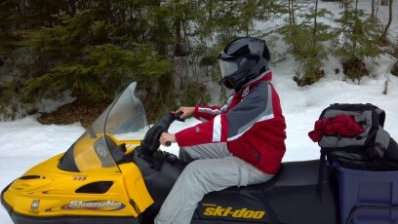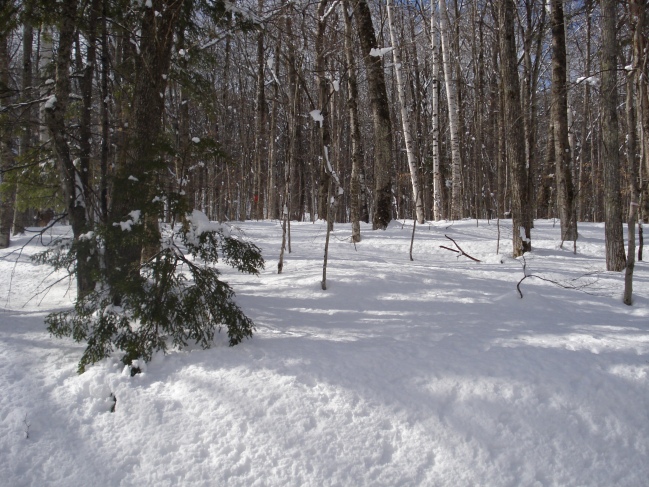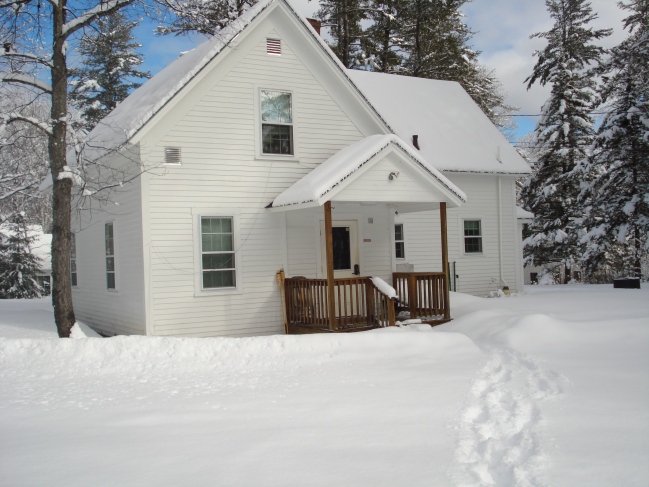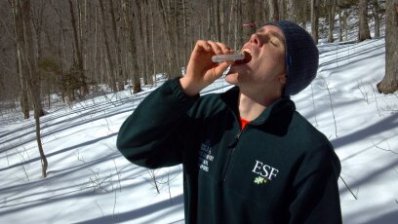Filed under: Winter
By Adam Wild
*View from Bear Notch Road in the winter
As winter temperatures begin to warm and the first signs of winter drawing to a close appear, if you listen very carefully you can hear something mysterious happening in the Shoestring plots. Drip…….drip…..drip. Blanketed in over a meter of snow and no rustling leaves, the woods are eerily silent except for an occasional snowmobile tourist or dog sled team on Bear Notch Road and drip…..drip. The sound penetrates throughout the forest stand, drip……..drip. The sound is sweet to the ears, drip…..drip. What is the sound? It comes from the sugar maples trees releasing their sweet maple sap.
*Maple sap dripping into one of my test tubes for analysis
* Shoestring Stand C8, plot 1 in the winter
After spending a summer in the Shoestring plots where ther e is a lot of hustle and bustle it is strange to be in the shoestring plots in the winter all alone. The woods open up into new views not visible during the summer months. The forest is peaceful in the winter as the trees are enjoying a nice long rest from all the Shoestring Interns. However, near the end of winter they starts to wake up in anticipation of a new group of awesome young scientist who will come and feed them either N, P, N&P or Ca (the control trees are not quite as happy as they get nothing) and who will come asses how well they’re performing. The trees like to think of us as doctors or even officials in a fierce competition where each one is trying to prove they are better. 
*Bear Notch Road is only accessible by snowmobile in the winter
* I was only able to access a couple of the stands by skiing in with all my gear
Freezing temperatures at night and day time temperatures above freezing allow the magnificent sugar maples to draw up their sweet sap into their branches at night and release back down into the roots when it thaws. The sap can be collected as it drops back down the tree and boiled down to make maple syrup, yum! No pancake is complete without tasty maple syrup. My project is to go around to the Shoestring sugar maples and test the sweetness of their sap and see whether the nutrient additions increase the sweetness of the sap. Sweeter sap allows you to make more maple syrup from the same amount of sap. More maple syrup, more pancakes!
* Fresh Maple Syrup I Made
* The White House in The Winter
*Testing the Sweetness of Maple Sap with a Digital Refractometer
*Enjoying Fresh Maple Sap
~Adam
With much joy I can report there are no black-flies or mosquitoes out in the stands today. Of course it was a bit windy, gusting over 2o and a bit cold, somewhere around -10C. Such conditions will deter even the mightiest of pesky biting bugs or so I have heard. After spending so much time through summer and fall my curiosity got the best of me. I had to see at least some of the MELNHE stands under cover of snow.
A solo trip would not be a good idea so I recruited Sean, volunteer on the leaf litter decomposition experiment and assistant emptier of baskets for the fall basket collection. Somehow, he hasn’t learned yet that I have a few crazy ideas and agreed to join the expedition.
Skiing up Bear Notch Rd. in winter was rather pleasant. Most often the gusts were above us as the road cuts across the terrain. Local snowmobile enthusiasts groom the road so the snow was in near perfect condition. With all the blowing and some falling snow, there was little to look at along the way save for the trees at hand. I did notice a number of areas still exposed bare from the previous melting events, now frozen solid.
Given all the melting from rain and warm weather recently I was surprised at the overall depth of the snow in the woods. Nearly one meter in places. The snowpack left by the Nor’easter last weekend had added some good depth. The result was that no corner posts were visible. Ok, we didn’t look that hard, but the obvious ones were buried and the plot signs were at about DBH or lower. Skiing in the woods is always fun and I love the open spaces between big trees. Skiing through tight trees is also fun (read “hair-raising”) but I had never experienced young stand skiing before, glad I had eye protection on!
Skiing down the road was pleasant although less so then the trip up. The exertion of the climb had kept me warm earlier, not so for the downhill. Each stop along the way I had to shake my hands out to get the blood back but that is typical for the Whites this time of year. Getting out into the woods in winter means cold fingers and toes. But since I can type this out I guess I recovered just fine!
-Rick
The Shoestring crew has arrived to Bartlett, NH and are already hard at work for the 2011 field season!
For newcomers to our blog here is a general project description (please learn more at http://www.esf.edu/melnhe/):
Researchers in the Multiple Element Limitation in Northern Hardwood Ecosystems (MELNHE) project are studying N and P acquisition and limitation through a series of nutrient manipulations in northern hardwood forests. The project has also been known as the Shoestring Project, since work began on it years before it was funded.
Although temperate forests are generally thought of as N-limited, resource optimization theory predicts that ecosystem productivity should be co-limited by multiple nutrients. To test the patterns of resource limitation, we are conducting nutrient manipulations in three study sites in New Hampshire: the Bartlett Experimental Forest, the Hubbard Brook Experimental Forest, and Jeffers Brook in the White Mountain National Forest.
At Bartlett, we have three replicate stands of three ages (~20, 30, and > 100 years). At Hubbard Brook and Jeffers Brook, there are two stands at each site, corresponding to the mid-aged and mature stands at Bartlett (total 13 stands). In each stand, there are four treatment plots, each 1/4 ha (50 m x 50 m), treated with N (30 kg/ha/yr as NH4NO3), P (10 kg/ha/yr as NaH2PO4), N+P, or control, beginning in spring 2011. At 5 of the 13 stands, we also have a Ca treatment plot (3500 kg/ha as CaSiO3).
We are monitoring stem diameter, leaf area, sap flow, foliar chemistry, leaf litter production and chemistry, foliar nutrient resorption, root biomass and production, mycorrhizal associations, soil respiration, heterotrophic respiration, N and P availability, N mineralization, soil phosphatase activity, soil carbon and nitrogen, nutrient uptake capacity of roots, and mineral weathering. Results will be posted as they develop.
This blog documents the experiences of the crew (Shoestringers) partaking in the field work for this project.
Collaborators that have recently joined the study include Mark Greene from Plymouth University and Heidi Asbjornsen from UNH who will both be working on sap flow components of the study.
This year we welcome back SUNY ESF graduate student Kikang Bae, who will be working on filming the minirhizotrons installed last summer, and continuing with her soil respiration measurements.
We also welcome new graduate students Craig See, Shinjini Goswami, and Russell Auwae to the Shoestring Crew! Craig will be taking over the foliar nutrient resorption project under the guidance of Ruth Yanai at SUNY ESF. Shinjini and Russell will be working under the guidance of Melany Fisk at Miami University of Ohio. Shinjini will be taking control of the MELNHE stand inventory this summer.
We also welcome our undergraduate field crew members Lin Liu, Zhen Yu “Amos” Lim, Kelly Nywening, Neil Smeltzer, and Christy Tanner.
We are excited to have two science teachers joining our crew this summer! We are lucky to have back Lisa Lavalley, who teaches at Pinkerton Academy in Derry, NH. Joining her this year is Sara Rice who teaches at Kennett Middle School in Conway, NH.
You will be hearing from each of our crew members this summer!
The big ticket item on this year’s agenda is stand fertilization! The crew is already in the midst of carefully spreading Monosodium Phosphate and Ammonium Nitrate on the forest floor in Bartlett. You will soon be hearing from a crewmember on the details of the fertilization process. C6 was our first stand to be fertilized and was finished yesterday. Today Kelly, Lin, and Shinjini are finishing fertilizing the plots at C1, our youngest stand. Craig, Becka, and Amos are finishing fertilizing C2, our second youngest stand. Both crews are then heading to C4 (one of our mid-aged stands) to start the fertilization process there. The going is slow, but we started in the most difficult stands, so bravo crew, way to go!
The fertilization countdown: 1 stand down, 12 to go.









